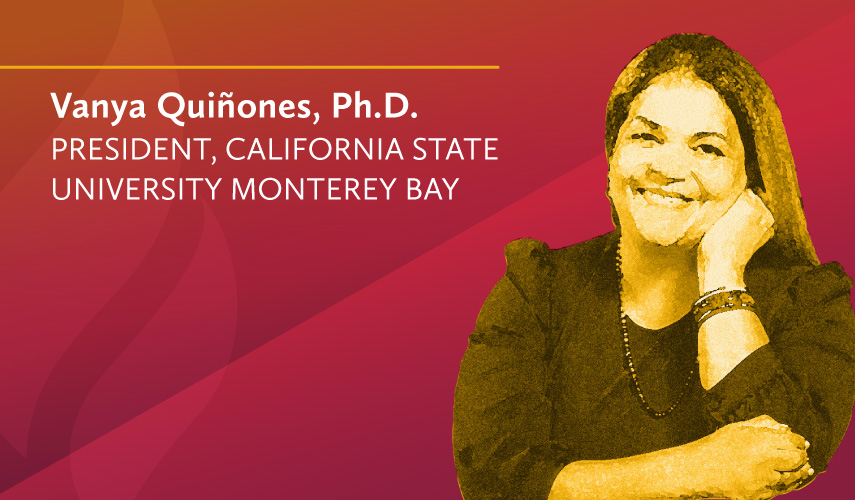
Courageous Leadership
Leading Through the Unknown
By Vanya Quiñones, Ph.D., President of California State University, Monterey Bay
As a scientist, I’ve always trusted data. But leadership has taught me that data alone is not enough—you must also trust your gut. Together, data and instinct shape a vision that others can rally behind.
At this moment, higher education is facing challenges that test even the most experienced leaders. Institutions confront the demographic cliff, competing for a shrinking pool of students while managing rising operational costs. Navigating these waters requires bold decision-making that ensures our institutions’ long-term viability while guiding people through uncertainty. The challenge lies in doing this without causing panic, maintaining trust and transparency, and focusing on what can be controlled in an unpredictable future. In such moments, trusting your vision and instincts becomes crucial.

Vanya Quiñones
Learning to Trust Yourself
Visionary leaders often step into uncharted territory, which can be daunting. But I’ve learned that courageous leadership begins with trusting yourself.
During the COVID-19 pandemic, when I was provost and executive vice president for academic affairs at Pace University, this lesson became clear. In January 2020, long before the broader public grasped the full implications, I saw the need to prepare. Trusting both the data and my instincts, I approached the university leadership and urged action. Although some believed I was overreacting, I knew we couldn’t afford to wait.
Thankfully, they listened. By March, our faculty were certified in online teaching, and Zoom was fully operational before the shutdown began. While other institutions scrambled to adjust, we smoothly transitioned to online learning and reopened by summer 2020.
I’ve learned not to fear being the first, as long as I’m confident in my direction. When decisions are made with students’ best interests at heart, we are on the right path.
Sharing Your Vision
My experience at Pace solidified my leadership philosophy: always think ahead. Many make decisions based on current data, but I focus on where we’re headed. I often ask, “What will this decision look like in the future?” Gaining buy-in can be challenging, especially when others don’t share your perspective. Helping your team understand the “why” and “how” of a vision is essential, as is maintaining transparency and open communication.
I’ve learned not to fear being the first, as long as I’m confident in my direction. When decisions are made with students’ best interests at heart, we are on the right path. Leadership means balancing student success with team well-being, ensuring progress without overwhelming those who make it possible or altering our institution’s core values.
Adapting Your Approach
Being a visionary can be challenging, especially when asking others to rethink their ways of working. When I joined Cal State Monterey Bay, I sensed that the university wasn’t operating sustainably. Like many institutions, we faced enrollment pressures, budget constraints, and inefficient systems. I saw from the data that enrollment had been declining for nearly seven years without corresponding budget adjustments.
While I had previously used data to highlight needed improvements, I knew a unique approach was necessary for Cal State Monterey Bay. I launched a 100-day listening tour, meeting with faculty, staff, and students. By analyzing these conversations, I identified patterns that highlighted the need for more communication, improved student experience processes, and a sustainable budget model.
Working with my leadership team, we set targets for reductions and strategic investments, aiming to stabilize our finances while maintaining a reserve. Transparency was key; we held town halls, maintained an active university budget committee, and communicated regularly through email updates. These efforts helped us navigate change, and I’m pleased to report a recent enrollment increase—the first in seven years. Watching our new students march down the main road at convocation was a powerful reminder of our commitment to stability and student success.
Now, other universities look to our team for guidance as they face similar challenges.
The Power of Collaboration
Higher education traditionally moves slowly, yet the world around us is evolving rapidly. As someone who has worked in academia for many years, I have collected many tools and recipes for success. But as with real-life cooking, we sometimes need to adapt our recipes to the ingredients we have readily available. Each institution is different and has its own unique opportunities and challenges. As a leader, it is important for me to take time to understand the culture and learn the strengths of my leadership team, and then to adapt the recipes I have developed through my years working in different places to what is best suited for my current institution. Of course, trust is a fundamental ingredient, as it grounds us to face challenges together.
To me, trust means empowering team members to make decisions and fostering collaboration across the institution. Coming from a farming family, where everyone worked for the collective good, I’ve applied that collaborative mindset to our team dynamics, promoting partnerships across our divisions of Academic Affairs, Enrollment Management and Student Affairs, Administration and Finance and the Office of the President. I encourage leaders from different areas to connect, aligning their strengths toward a shared vision.
As a leader, when you understand the strengths of each team member and can align them all together, your institution moves faster toward strategic goals and can be more agile in responding to emerging issues. You end up with greater power as a whole than if each individual person is acting on their own. I’ve achieved this at multiple universities through restructuring committees to encourage communication among mid-level leaders, solving problems efficiently and creating lasting impact. True leadership is not imposing authority, but creating a team that fosters a collaborative culture to empower progress toward collective goals.
Commencement is a day that exemplifies all of these efforts. Not only does it bring together leaders, faculty and staff from each of our divisions to celebrate the milestone of graduation with our students and their supporters, but it also symbolizes the collective work we have done together year-round. By empowering our community to make decisions, aligning goals across the institution and working together, we are successful in graduating our students to the next phase of their careers or education, and ensuring they have the tools they need for long-term impact across our region and state.
Advice for Today’s Leaders
Leadership is both a privilege and a journey of growth. We are all works in progress, constantly learning from mistakes and growing stronger. Courageous leadership means having a vision, trusting your instincts, leveraging what you’ve learned, and aligning your team’s strengths to achieve goals. If you can do this while prioritizing what’s best for students, you can lead your institution through any challenge.

